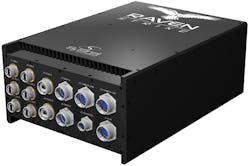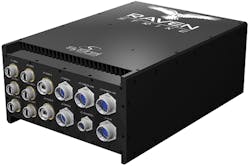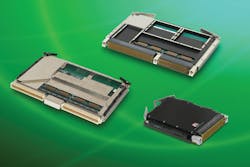SWaP considerations for today’s rugged computers
Systems integrators require small size, weight, and power consumption (SWaP) for today’s rugged computer systems, embedded computing boards, and rugged backplanes, which is pushing vendor innovation to the limit.
By Jamie Whitney
Industry innovators are accomplishing breakthroughs with commercial off-the-shelf (COTS) solutions to tackle specialized problems in military systems that must operate in extreme conditions. By using off-the-shelf components, manufacturers can mate affordable, proven technology into proprietary designs that can stand up to the conditions of the modern battlefield on land, in the air, or at sea.
With COTS components, manufactures and contractors of mil-spec hardware can continue to do what they do best: put rugged and ready equipment onto the battlefield.
Cooled with COTS
This fall, rugged embedded computing specialist General Micro Systems (GMS) in Rancho Cucamonga, Calif., introduced one of the industry’s first rugged, conduction-cooled COTS deep learning and artificial intelligence to provide real-time data analysis and decision making on the modern battlefield with its X422 Lightning system. It integrates two Nvidia V100 Tesla data center accelerators into a sealed, conduction-cooled chassis that enables it to function in extreme conditions.
The X422 is a forward deployed, vehicle-mounted, high-performance general-purpose graphics processing unit (GPGPU) co-processing system. Applications include computing clusters and parallel computing, digital signal processing, digital image processing, video processing, neural networks, data mining, cryptography, and intrusion detection.
Systel Inc. Raven-Strike rugged multi-mission computer
Traditionally, sensors on military vehicles collect massive amounts of battlefield data and store it locally before transporting it for analysis and interpretation by sophisticated remote deep-learning systems. Transporting this raw data saturates networks and satellite communications uplinks, slowing them to a crawl and preventing access from other users. To work around the network, warfighters often transport removable hard disk drives from the front lines, leaving the data subject to theft or loss during transport and introducing additional lag time.
“The X422 GPGPU system allows extraordinary quantities of data to be collected and processed right on the battlefield in real time, significantly shortening the decision loop for providing solutions and recommendations to warfighters,” says Ben Sharfi, chief architect and CEO at General Micro Systems. “Ultimately, the X422 enables live targets to be identified, flagged, and even fired upon in record time. It represents a complete paradigm shift in electronic warfare, SIGINT [signals intelligence], and C4ISR [command, control, communications, computers, intelligence, surveillance, and reconnaissance].”
Advanced GPGPUs
The X422 fits its GPGPU system into an approximately 12-by-12-inch square sealed enclosure that sits approximately three inches high. It includes dual x16 PCI Express Gen 3 slots for the GMS-ruggedized PCI Express deep learning cards, including Nvidia’s V100 Tesla (computation only)—what Nvidia calls the “most advanced data center GPU ever built,”—or Nvidia’s Titan V (computation with graphics outputs). Each card boasts 5120 CUDA processing cores, giving X422 over 10,200 GPGPU cores and more than 225 teraFLOPs for deep learning.
In addition to using Nvidia GPGPU co-processors, the X422 can accommodate other co-processors, different deep learning cards, and high-performance computers (HPC) based upon FPGAs from Xilinx or Altera, or ASICs up to a total of 250 Watts per slot (500 Watts total).
An industry first for deep learning and artificial intelligence, the X422 includes no fans or moving parts, promising wide temperature operation and data movement via an external PCI Express fabric in ground vehicles, tactical command posts, UAV and UAS, or other remote locations.
Elma Electronic high-speed 3U VPX backplane
“No one besides GMS has done this before because we own the technology that makes it possible,” Sharfi says. “The X422 not only keeps the V100s or other 250-Watt GPGPU cards cool on the battlefield, but our unique x16 PCI Express Gen 3 FlexVPX fabric streams real-time data between the X422 and host processor and server at an astounding 32 gigabytes per second all day long. From sensor to deep learning co-processor to host: X422 accelerates the fastest and most complete data analysis and decision making possible.”
Unique to X422 are the pair of X422’s two PCI Express deep-learning cards that can operate independently or work together as a high-performance computer (HPC) using the user-programmable onboard, non-blocking low-latency PCI Express switch fabric. For PCI Express cards with outputs — such as the Titan V’s DisplayPorts — these are routed to separate A and B front panel connectors.
Another first of its kind
Elma Electronic in Fremont, Calif., also unveiled ground-breaking technology this fall with its 3U OpenVPX backplanes. These backplanes support integration of mixed payload modules — including COTS single-board computers, switches, and RF payloads used by the U.S. Department of Defense (DOD) Hardware and Software Convergence Initiative.
Unique to this backplane is its support of high-speed signals on all the data paths as well as leading-edge VITA 67.3 connectors compatible with legacy VITA 67.1 and VITA 66.4 RF and optical I/O connectors.
Designed to align with the DOD’s Hardware and Software Convergence Initiative, which aims to develop a common, modular hardware architecture across C4ISR and electronic warfare (EW) systems, the backplane contributes to optimized size, weight, and power consumption (SWaP) requirements and relatively low life cycle costs to enable rapid technology insertion for the soldier.
Ken Grob, director of embedded computing development at Elma says, “This latest backplane incorporates new VPX features, unmatched by any other embedded backplane architecture to date, that will allow the VPX architecture to address a range of applications.”
Aitech Defense Systems Inc. NXP T4xx1 Series multicore QorIQ PowerPCs
This 3U 12-slot VPX backplane has a radial slot card for timing and synchronization, and includes seven slots that receive radial clock signals (Aux Clk and Ref Clk) driven independently from a radial clock timing card. The remaining five slots receive standard VPX bused Aux_Clk and Ref_Clk signals. The timing card slot also supports a VITA 67.3c connector with 10 simultaneous multi-protocol management (SMPM) cavities.
Four payload slots, each equipped with a combination VITA 67.3c optical and RF connector in the J2 position also are featured on the backplane. The slot 2 switch supports a VITA 67.3d connector module compatible with a payload module fitted with a VITA 66.4 MT optical ribbon connector or a VITA 67.1 RF coaxial connector.
When equipped with optical interfaces, the VPX architecture now allows data rates across the backplane far greater than any copper interconnect, with the additional benefit of relatively low design complexity. The VPX optical interface ensures that this backplane will be able to meet future bandwidth requirements.
Also included on the backplane is a 12-cavity, VITA 67.3e connector to support an RF switch card. The new VITA 67.3 connectors allow mating and removal of high speed optical and RF interfaces on payload modules from the backplane. The scheme allows different types of I/O cabling routed to a slot to remain connected to the rear of the backplane to distribute interfaces.
Rugged and ready
Extreme Engineering Solutions (X-ES) in Verona, Wis., also is bringing its own COTS solution to the 3U VPX field as its XPand6215 allows for high-bandwidth data acquisition and signal processing in harsh environments thanks to multiple high-speed optical links. The XPand6215 is a COTS rugged system based on the Intel Xeon D-1500 family of processors and the Xilinx Kintex Ultrascale field-programmable gate array (FPGA).
The XPand6215 is a small form factor (SFF) system composed of two 3U VPX modules. In the first slot, the XPedite7670 single-board computer features an Intel Xeon D-1500 (formerly Broadwell-DE) processor, offering as many as 16 Xeon-class cores in one power-efficient system-on-chip (SoC) package. The XPedite7670 hosts an XPort3305 10 Gigabit Ethernet XMC module, which provides a 10GBASE-SR Ethernet port through a fiber connector on the XPand6215 front panel.
Systel Inc. Falcon-Strike rugged multi-mission computer
Eight lanes of PCI Express Gen3 connect the XPedite7670 to the XPedite2570 in the second slot. This high-performance reconfigurable FPGA processing module is based on the Xilinx Kintex Ultrascale XCKU115 FPGA. The XPedite2570 provides 12 fast protocol-independent fiber-optic transmitters and receivers, accessible through a second fiber connector on the XPand6215 front panel.
The XPand6215 meets MIL-STD-810 and DO-160 standards while integrating power-saving and performance-enhancing technology. The heat from the internal conduction-cooled modules moves to sidewall heat exchangers, where dissipates to the ambient environment by convection cooling and to an attached cold plate by conduction cooling. The system includes an integrated 28-volt DC power supply and MIL-STD-461 electro-magnetic interference (EMI) filtering.
High performance, low power
Thanks to the ultra-low power T4xx1 processor integrated into four of its high-performing single-board computers, Aitech Defense Systems Inc. in Chatsworth, Calif., has further reduced power conception in its 3U and 6U VPX; 6U VME, and 3U VPX bundled computer boards.
Aitech officials say power consumption on the four single-board computers can be reduced up to 21 percent. By further reducing power consumption within the board itself, Aitech helps designers meet the challenges of SWaP-C optimization throughout several rugged and mobile environments.
“Our customers face new and challenging design obstacles every day,” says Emil Kheyfets, Aitech’s director of military and aerospace product management. “As system size shrinks and electronics density increases, it’s our job to provide solutions to solve these challenges, while keeping costs in line with budget requirements. Developing a range of powerful multicore single-board computers with cost-effective, relatively low cost-per-watt options enables them to meet the thermal profiles of today’s highly integrated, embedded systems.”
Systel Inc. HR3000 rugged rack-mounted server
The low-power Aitech embedded computing series is available on the C912 3U VPX single-board computer, which offers as many as 12 e6500 PowerPC cores, as well as on the C111 6U VME and C112 6U VPX single-board computers, all of which have NXP’s Trust Architecture 2.0.
This technology provides a high-trust cyber security processing environment for sensitive data security and supervisory control, a typical requirement for manned and unmanned space, air and ground vehicles.
The T4xx1 Series is 100 percent software compatible with the original T4xx0 family, meaning designers can use either on the Aitech COTS single-board computers, depending on their individual application requirements. The low-power processors offer an extended temperature range of -40 to 105 degrees Celsius on all 1.8 GHz speed bins as well as thermal power reduction of as much as 21 percent, depending on the device and speed bin selected.
Ready to ‘Strike’
Systel Inc. in Sugar Land, Texas, was able to harness the processing power of Intel’s Xenon scalable microprocessor and NVIDIA’s GPGPU in its new Raven-Strike combat vehicle computing system. The rugged mission computer is purpose-built for modern fighting vehicles, and records full HD video with capture and encode, and sensor integration and data fusion. Raven-Strike is a SWaP optimized system, company officials say.
The computer integrates maximum compute and networking throughput and enables deep learning and artificial intelligence capability through the use of neural networks. Systel’s advanced thermal management ensures survival in extreme operating conditions, and Raven-Strike is built to exceed harsh military specifications including shock, vibration, dust, water, EMI, and EMC.
“Raven-Strike is a best-in-class rugged computing solution,” says Aneesh Kothari, vice president of marketing for Systel. “It provides minimal SWaP with maximum CPU and GPU core density and acts as a single point for all sensor ingest and data fusion. Raven-Strike is the next-generation of computing technology demanded by emerging mission demands.”
The sealed unit can operate in -40 to 55 C temperatures and withstand mil-standard 810 G-level shock and vibration as well as the mil-standard 461 EMI, all in a 14.2-by-20.6-inch sealed enclosure that stands 7.6 inches high.
Second ‘Strike’
Systel also offers the Falcon-Strike combat vehicle computing system in a smaller package. While the Falcon-Strike also meets the same mil-spec requirements of the Raven-Strike, it fits the system in an 8-by-9.5-inch enclosure that stands 6 inches tall. The Falcon-Strike uses either an Intel Xeon E3-1505L Quad-Core or i7-6822EQ Quad-Core microprocessor with a NVIDIA GeForce GTX 1050Ti 768-core CUDA GPU.
“Falcon-Strike exceeds the technology challenges and performance specifications demanded by modern Defense programs and platforms,” says Systel’s Kothari. “It provides an unmatched processing combination of high-performance CPU and GPU, ultra-efficient multi-sensor capture and encode, I/O and board scalability, and secure storage — all in a SWaP-optimized, single line-replaceable unit.”
Falcon-Strike is for mission-critical military operations involving intelligence, surveillance, and reconnaissance (ISR), counter-unmanned aircraft, persistent surveillance, airborne law Enforcement, search and rescue (SAR), and land and marine based missions.
Mount up
The BR3000 rackmount server from Systel in its Puma-Bolt class also brings COTS value in a durable mil-spec package. HR3000 offers great value and performance without high cost. Custom integration and testing are available for dock-to-stock solutions for varied sectors, including military, oil field, and industrial applications.
The HR3000 is a SWaP-optimized 3U server with the latest Intel Xeon scalable processor and NVIDIA GPGPU and has the capability for PCI Express 3.0 add-in cards. The server has three hot-swap removable high-density SSDs. It is a half-rack width and short depth system. HR3000 is actively used in expeditionary warfare missions.
Company list
Aitech
Chatsworth, Calif.
http://www.rugged.com
Crystal Group
Hiawatha, Iowa
https://www.crystalrugged.com
Curtiss-Wright
Ashburn, Va.
http://www.curtisswrightds.com
Extreme Engineering Solutions
Middleton, Wis.
https://www.xes-inc.com
General Micro Systems
Rancho Cucamonga, Calif.
https://www.gms4sbc.com
Kontron
Fremont, Calif.
https://www.kontron.com
Mercury Systems
Andover, Mass.
http://www.mc.com
Panasonic USA
Newark, N.J.
http://www.toughbook.com
Systel
Sugar Land, Texas
http://www.systelusa.com
Acromag
Wixom, Mich.
https://www.acromag.com
ADLINK Technology
San Jose, Calif.
http://www.adlinktech.com
Chassis-Plans
San Jose, Calif.
http://www.chassis-plans.com/
Core Systems
Poway, Calif.
https://core-systems.com
Diamond Systems
Sunnyvale, Calif.
http://www.diamondsystems.com/
Ecrin
Crolles, France
http://www.ecrin.com/en
Elma
Fremont, Calif.
http://www.elma.com
GammaTech Computer Corp.
Fremont, Calif.
https://www.gammatechusa.com
Getac
Irvine, Calif.
http://www.getac.com
HHCS Handheld USA Inc.
Corvallis, Ore.
https://www.handheldgroup.com
MilDef Inc.
Alexandria, Va.
https://www.mildef.com
Sparton Rugged Electronics
Woodbridge, Ontario
https://www.spartonre.com
Technology Advancement Group (TAG) Inc.
Dulles, Va.
https://www.tag.com
V Rose Microsystems
Johnstown, N.Y.
http://www.vrosemicrosystems.com
Xplore
Austin, Texas
https://www.xploretech.com






